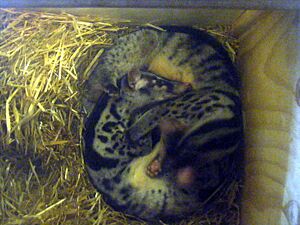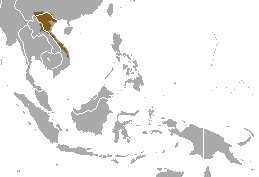Owston's palm civet facts for kids
Quick facts for kids Owston's palm civet |
|
|---|---|
 |
|
| Owston's palm civets in captivity | |
| Conservation status | |
| Scientific classification | |
| Genus: |
Chrotogale
|
| Species: |
owstoni
|
 |
|
| Owston's palm civet range | |
The Owston's palm civet (scientific name: Chrotogale owstoni) is a special animal that looks a bit like a cat and a weasel. It belongs to a group of animals called viverrids. This civet lives in the forests of Vietnam, Laos, and a small part of southern China. Sadly, this animal is listed as Endangered, which means its numbers are dropping fast. Scientists believe its population has gone down by more than half in recent years. This is mainly because of too much hunting and the destruction of its forest home.
Contents
What is an Owston's Palm Civet?
The Owston's palm civet was first described by a scientist named Oldfield Thomas in 1912. He studied a skull and skin of an animal collected by Alan Owston near a river. The Chrotogale is a unique type of civet, meaning it's the only species in its group.
Appearance
The Owston's palm civet has a body that is a mix of tan, buff, and grey. It has very clear black stripes and spots. You can see four black bands running along its back, starting from around its eyes and going down to about one-third of its tail.
It has big, round ears and dark, black eyes. This civet is a medium-sized animal. Its body is about 57 centimeters (22 inches) long, and its tail adds another 43 centimeters (17 inches). It usually weighs between 1.8 and 2.7 kilograms (4 to 6 pounds). The last two-thirds of its tail are completely black. It also has black spots on its legs.
Both male and female Owston's palm civets are quite slender. They look very similar, with the same markings. The only way to tell them apart is by looking at their fur color on their bellies. Females have an orange patch only on their lower bellies. Males have a larger orange patch on their chest, and it's a different shade of orange than the females'.
Where They Live
Owston's palm civets live in lowland evergreen forests. These are forests where the trees stay green all year, and the dry seasons are not too harsh. They live in a specific area that includes Vietnam, Laos, and a small part of southern China. They are also found in the Annamite mountains.
Studies using camera traps suggest that they only live in certain types of forests within these regions. These include moist tropical evergreen forests, subtropical forests, and limestone forests.
Behavior and Life
Scientists don't know much about the daily lives of Owston's palm civets in the wild. Most of what we know comes from studying animals in zoos or rescue centers.
These civets are usually solitary, meaning they live alone. The only time they might be with others is during mating season. They are also nocturnal, which means they are active at night. In the wild, they are active only when it's completely dark. In captivity, they are active from sunset to sunrise.
Owston's palm civets spend most of their time on the ground. They look for food on the forest floor. Sometimes, they might climb trees and bushes to sleep. They mark objects using their urine and special scent glands on their bellies. This marking happens more often during breeding season, but scientists are not sure why they do it.
Diet
The Owston's civet spends most of its time searching for food on the ground. They mainly eat fruits and soft-bodied animals. They especially love insects and earthworms. Because of how their teeth are shaped, they cannot eat large or bony animals.
Reproduction
We don't have much information about how Owston's palm civets reproduce in the wild. However, based on when traders see pregnant females, it's thought that their mating season is between January and May.
In captivity, female civets usually give birth to 1 to 3 babies. The babies are born after about 75 to 90 days. When they are born, their eyes are closed, and they weigh about 80 to 135 grams (2.8 to 4.8 ounces). After about 10 days, they start to walk. They become independent when they are 12 to 18 weeks old, which is when they stop drinking their mother's milk.
Threats to Their Survival
The Owston's palm civet is listed as Endangered on the IUCN Red List. This means their population is shrinking quickly. The main reasons for this decline are too much hunting and their forest homes being broken up into smaller pieces.
The biggest threat is hunting, especially traps set for many different kinds of animals. Even though the Owston's palm civet is not always the main target, many civets get caught in snares. Snares are traps that catch animals by their legs or neck. Most of this hunting happens inside protected areas, where setting traps is against the law.
People in cities want wild meat, which has led to more hunting both inside and outside protected areas. In some parts of Vietnam and Laos, there can be hundreds of snares for every kilometer of forest.
Helping the Civets
To help save the Owston's palm civet, special protected areas have been created in the Yunnan province of China. In Vietnam, it is illegal to hunt them without special permission. In Laos, hunting the Owston's palm civet is completely forbidden.
Conservationists have made a 10-year plan to help protect these civets. Their main goals are to stop the use of snares and reduce how much wild meat people eat. They plan to talk to governments about the wild meat issue. They hope new laws will help change people's behavior. They also want to create a healthy group of Owston's palm civets in captivity. These civets could then be released back into the wild.
In Captivity
The Carnivore and Pangolin Conservation Program in Cúc Phương National Park in Vietnam is very important. It was started in 1995. This is the only center that helps injured Owston's palm civets get better and also helps them breed. The program works with different zoos, like Newquay Zoo.
Since 1995, 14 Owston's palm civets have been rescued and cared for at the center. As of 2019, 66 civets have been born there. Newquay Zoo in the UK also has two Owston's civets that came from Vietnam in 2005.


